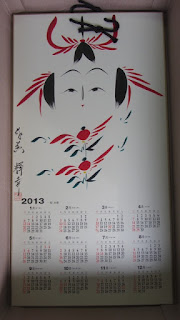 |
| The river running next to the Hiraga workshop. |
On day 2 of our big December adventure we slept in late, went into the onsen for a morning dip, and then headed back to the Hiraga's to say hello, view the kokeshis, and let the kids play in snow that accumulated over night. It wasn't as cold as the day before and we had beautiful blue skies with occasional flurries: Perfect weather for sledding and kokeshis, and I even got Mr. Hiraga to try out my old Burton Backhill snowboard!
Now that it was light out and we had rested, we finally had a good chance to examine all of Mr. Hiraga's new kokeshi creations closely. Again, he really does such fantastic, innovative things with little pieces of wood as you'll see in the pictures below. We had a nice morning chatting with the Hiragas and enjoying their hospitality. When lunch approached we walked across the bridge to a nearby ramen shop for lunch, and boy did that place have large bowls completely filled with noodles.
 |
| The view from our hotel's parking lot. We were right at the base of this small mountain. |
 |
| Playing in the snow next to the Hiraga's workshop. |
 |
| One of Mr. Hiraga's specialties are Christmas kokeshis. This giant-sized one was especially impressive. |
 |
| But wait, there's more! The giant Santa was hollow, and would perhaps be good for storing cookies or other kokeshis. Naoko was severely tempted by this piece, but in the end decided to wait. |
 |
| We first were introduced to Mr. Hiraga's work by one of these onsen kokeshis, which actually has a small cloth towel on its head. What a great idea, especially since the kokeshi tradition is so thoroughly connected to hot bath towns. The black one with the eye patch is the Date Masamune kokeshi that I described in the previous blog. |
 |
| Most kokeshi makes also make Darumas, all of which are different. This is Mr. Hiraga's version. |
 |
| More nice kokeshis. These were quite small. |
 |
| More. |
 |
| A 10,000-yen giant Hiraga kokeshi. That's a complete bargain by way. Those others are medium-sized. |
 |
| A new tourist pamphlet for things to see and do in the Sakanami-Akiu area. The front cover was drawn by Mr. Hiraga, while the back was done by another of our favorite kokeshi makers, Mr. Suzuki Akira whom we went to see later in the day. This pamphlet shows how much kokeshis are a symbol of this part of Japan. |
One thing that Mr. Hiraga was selling in his shop that really caught my eye were these kokeshi-art calendars. He had five different ones on display, and they are a great way to keep track of the year.
Next blog: Back to the Akiu artists' village.














Hello, thank you for this very informative blog ! It prevents me from working since yesterday.
ReplyDeleteI live in Tochigi, very near from gunma prefecture. I have some creative kokeshi as most of them are made in gunma. But i love tohoku ones too...
Do you know if the beauties you show on your blog are available on an online shop ?
Laetitia H, you are welcome and thank you for your nice comment. I should probably do a blog post related to your question, but let me see if I can get you started. First of all, though, you live in Tochigi which is right on the southern border with Fukushima. That's means you are just a couple of hours south from Tsuchiyu Onsen, which is a center of one of the eleven traditional kokeshi families. If I understand MEXT's radiation info correctly, the levels there are about .20 microsieverts, which is much, much less radiation than what you'd be exposed to on, for example, a trans-Pacific flight. Please check this, but since you're so close I have to recommend that first. Now, if you can't get up to Tohoku, do you ever get to Tokyo? We have the monthly Kokeshi Friends meeting where you can see and purchase lots of great used kokeshis. Recently there have also been a number of Tohoku handicraft events in Tokyo that typically include traditional kokeshis. I believe one is coming up soon in February -- I'll try to announce that on the blog. As for purchasing on line, I've never really done it but my wife Naoko has, usually directly from the craftsman. If you can read Japanese then you really shouldn't have a problem. Here's a link to a page on the Kokeshi Friends site that includes a number of links directly to the craftsmen (middle column): http://www.tokyo-kokeshi.jp/link/link_list.htm
DeleteDon't forget to check out weekend flea markets in your area -- there are usually used kokeshis available for fair prices. Of course there's always eBay and Yahoo Auction which you've probably explored. I've never done that myself though. Ah yes, in case you don't read Japanese here's "traditional kokeshi" for you: 伝統こけし. Just copy and paste that into Google and you'll get lots of hits, many of which offer sales. I hope this helps! Best regards, John